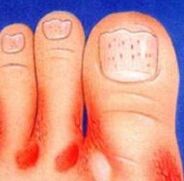According to statistics, each tenth population of our planets has a foot fungus or, as it is called, epidermophytosis. Often, men suffer from the disease, which is more caused by not many physiological features as the fact that male representatives are more frequent and longer than women, they wear closed shoes.
Fungus in the foot: causes and risk factors
The disease can be provoked by one of the following reasons:

- Insufficient body hygiene in general and feet in particular;
- uncomfortable and too close shoes;
- Excessive sweating;
- Violation in the work of the human immune system;
- flat feet etc -other types of foot deformation;
- the use of public pools and baths;
- Insufficient bath and bath cleanliness;
- Overweight;
- Problems with blood circulation in the feet.
General symptoms of foot fungus
Fungal on the feet can be real in different ways:
- inflammation of the skin on the heel and the pillow;
- Different itching -Different levels of severity;
- cracks;
- peel off.
The accurate determination of the foot fungus will help choose the right treatment of the disease.
Fungus on the feet and its kind
In the field of medicine, it is common to secrete 3 main types of fungus: membranes, such as moccasin, vesicular. And each one exists in both general symptoms and characteristics.
Membrane fungus sign:
- Localization in the 4th and 5th toes;
- Features of most types of fungus - scale;
- Itching.
The fungus on the feet of moccasin is different from the others:
- the thickening of one -the only foot;
- deeper cracks;
- painful sensations;
- Nail damage, which, such as the skin, thickens, at the same time gains excessive fragility, which can even cause the nail plate loss.

Vesicular fungus is characterized by: blisters filled with fluid and localization in the lower leg.
Foot fungus: diagnostics
The diagnosis of "foot fungus" is made by a dermatologist based on the patient's examination. More detailed studies: binding, skin biopsy, planting - will help doctors accurately determine the type of fungus that is impressive. In addition to all, doctors conducted a patient survey to show the disease in the past. The latter is very important, as the manifestation of fungus often for a certain period of time marks the transition of the disease in a worse form, which is more difficult to treat.
How to treat fungus on your feet?
Foot fungal therapy does not require stationary observation and is performed on an outpatient. In most cases, patients are prescribed external antifungal drugs. Keep in mind that often people suffering from foot fungus do not turn to experts at all, limiting themselves to taking drugs sold in pharmacies without a prescription. This scenario often leads to good results from the disease. However, keep in mind that the prolonged therapy of the disease, accompanied by deterioration in the leg condition, indicates the onset of the disease. The best way of this situation is to visit a specialist who will help choose the optimal remedy for fungus.



























